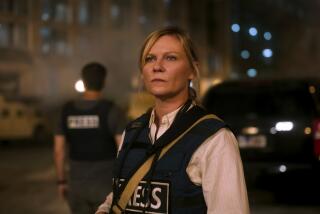Tribeca Fest: A new VR piece could spark a music-video revolution
- Share via
Reporting from NEW YORK — Pity the poor music video. First it was maligned for overuse, then it calcified into cliche. And just when it might have reinvented itself, it went away.
In recent years, the video has come back a bit, thanks to YouTube and Vevo. But that’s a revival largely of platform, not content. The ways music has expressed itself visually has not changed much in years, give or take the occasional OK Go video. And the people who could inaugurate such changes are, these days, often working somewhere else.
But all of that could shift with the advent of a new medium: VR
Virtual reality by its nature is well-suited for short, intense bursts of experience — exactly the raison d’etre of the music video. And songs are often best listened to cranked up on large headphones — exactly what VR encourages.
But I don’t think I fully recognized the potential for the form until I saw Tyler Hurd’s new piece “Old Friend” at the Tribeca Film Festival’s Virtual Arcade, which opened Monday and runs through the week. I’m not sure I can convey how transformational the piece is, at least for music video. If ever there was a piece of content you just had to experience to understand, this is it.
Lasting barely three minutes, “Old Friend” was made for the impossibly upbeat synth anthem of the same name by the Baltimore indie-pop band Future Islands (though they had nothing to do with this video; more on that in a second). Basically, Hurd’s piece features little more than an acid-trip set of characters — pastel-pink oompa-loompas, lime-green aliens, large Shrek-like creatures, a set of stylized marching-band members, others so colorfully costumed.
These figures move in concentric circles around the viewer in a kind of organized chaos, hypnotizing as they go. The creatures seem both to come at and move away from you. Everywhere you look, they swirl, smile, act like maniacs. And they encourage you to do the same.
Viewers, standing in the center of all this, are given control of Rubberman-arms that allow their moves to be reflected in the piece. While it’s not the kind of full-body first-person movement — telepresence, in industry parlance — that some other VR experiences aim for, it’s more than enough.
Movies and television have been trying to put us in new worlds since pretty much the moment they were invented. Video games have taken the first-person experience that much further. “Old Friend” advances all of those efforts. The combination of this particular song (you can hear the audio here) with this level of candy-colored immersion succeeds where many previously only dreamed. Indeed, resisting the urge to dance is a fool’s effort. Whatever mood you’re in, “Old Friend” will make it better. I did the experience twice, holding back a little the first time, then letting loose the second. (There’s no surveillance video of people using the piece — I hope.)
The video contains no narrative per se, though there is a kind of flow, and some hints at a larger story. But story isn’t the point. The point is the experience — or, more specifically, entering the world of the song.
“Everyone’s trying to figure out plot points with VR. And I just want to [mess] with people’s brains,” Hurd, an expressive man in his mid-30s said with a small laugh when I chatted with him outside the “Old Friend” demonstration at Tribeca.
Hurd worked for several years at the digital-studio Double Fine, where some of his collaborators included the same people who created the game-changing Tilt Brush. He also created an animated VR gems called “Butts,” about loneliness, several years back.
Hurd was listening to the Future Islands song on the subway in New York a few years ago and realized it conveyed a feeling that called for visual stimulation. And that visual stimulation, he soon realized, needed to be in VR, which can plunge the user into worlds better than any other. He soon went about creating what he calls “an overwhelming barrage of joyous nonsense.”
Eventually he secured the backing of the Venice-based startup Wevr, and “Old Friend’ will be made available on the company’s Transport platform, which aims to serve several headset systems.
The amazing thing is that, as of a day ago, Hurd had yet to succeed in connecting with the band; some interactions with Future Islands’ manager didn’t lead very far. As far as Hurd knows, the band hasn’t even seen his piece (Wevr did license the rights to the song). So what could prove to be one of the most influential music videos in years hasn’t even been seen by the band that soundtracks it. Such is the woolly nature of the VR movement.
A lot of factors will go into determining how many people will create music videos for VR, let alone watch them. But “Old Friend” is an example of what’s possible when music and immersive content are combined in new ways. In many respects, watching “Old Friends” reminded me of the early days of MTV, when the very idea of the music videos made clear that somethng new and medium-smashing and exciting was going on, even if we weren’t quite sure yet where it would all lead. The piece hints at a future in which VR music videos and the platforms hosting them are tangibly real--and thrillingly unknown.
Twitter: @ZeitchikLAT
ALSO:
Nine new VR pieces you need to know
Can movies like ‘Kicks’ usher in the next wave of Spike Lees?
Tribeca Fest: ‘Junction 48’ wrestles with race and violence amid Middle East rap scene
More to Read
Only good movies
Get the Indie Focus newsletter, Mark Olsen's weekly guide to the world of cinema.
You may occasionally receive promotional content from the Los Angeles Times.











